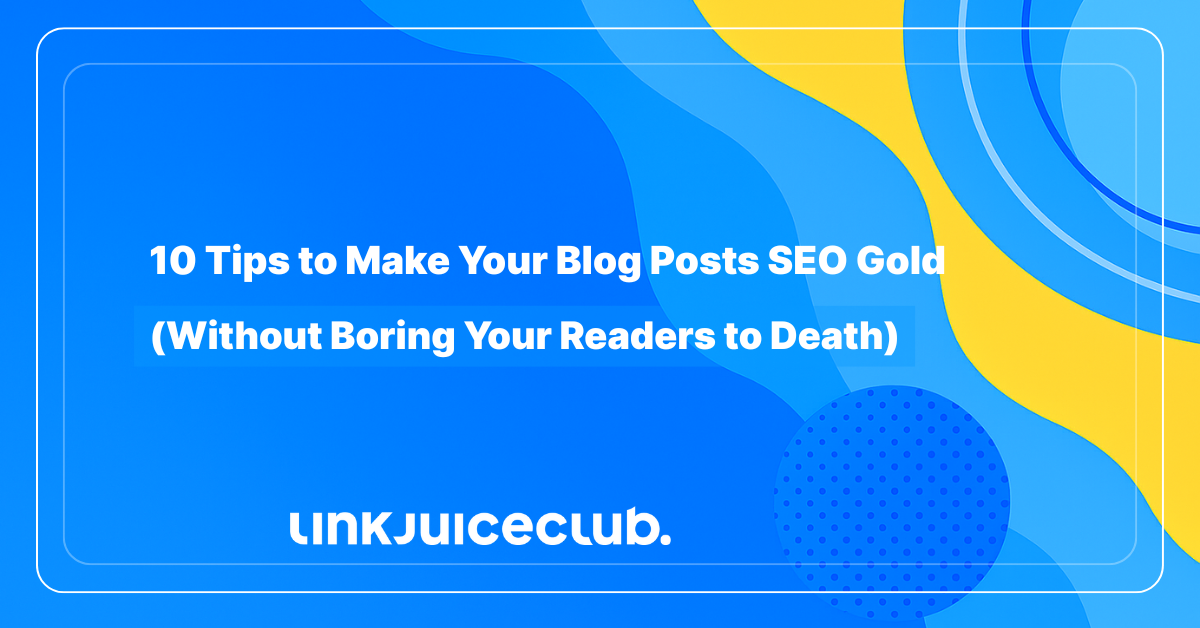
10 Tips to Make Your Blog Posts SEO Gold (Without Boring Your Readers to Death)
Writing great blog posts isn’t just about brain-dumping your thoughts and praying for clicks. If you want your content to rank, engage, and actually convert, you need a game plan.
Because in 2025, SEO-friendly blog posts are essential – it’s that simple.
Some people still believe there’s a battle between writing for search engines and writing for real humans. The truth is? The sweet spot is writing for both.
Yes, your blog posts need keywords, but not at the expense of clarity, tone, or vibe. Keyword stuffing is dead. Long live content that actually deserves its spot on page one!
Whether you’re new to blogging or just tired of publishing content that no one finds, we’ve got your back.
🔥 The experts at Link Juice Club have been in the trenches and dropped their favorite strategies for crafting blog posts that rank, get shared, and drive traffic that sticks. Ready to level up?

1. Nail Your Keyword Game Before You Write a Single Word
Before your fingers ever hit the keyboard, take a pause and open your keyword tools.
The foundation of all successful blog posts is solid keyword research. You need to know exactly what your audience is typing into search bars, not what you think they’re searching for.
If you want to own the SERPs, you’ve got to align your content with the real questions, problems, and curiosity your readers have.
Use Semrush, Ahrefs, or Google’s own Keyword Planner to dig up those golden terms. Once you’ve got a shortlist of juicy keywords and search phrases, map them to the blog post you’re about to create.
One main keyword, a few secondary ones and you’re ready to roll.
Blog smarter. Rank faster. And don’t forget: good research upfront means less guessing and more clicking later!
2. Build the Bones Before You Add the Meat
Ever read a blog post that felt like a rambling voice note? Don’t be that post!
Your blog needs structure. Start with an intro that sets the tone and teases the value. Then drop into a body that delivers the goods with clarity, flow, and purpose.
Finally, wrap it all up with a conclusion that ties the message together and points the reader to their next step.
Before writing a single paragraph, sketch this out in rough bullet points. It doesn’t have to be pretty; it just needs to give your post direction.
Think of it as your blog’s GPS. No more getting lost in your own ideas.
3. Paragraphs with Purpose, Headings with Swagger
Yes, you need paragraphs. No, they’re not just random line breaks when you feel like breathing.
Each paragraph should revolve around one single idea (not five!). If you can’t summarize it in one sentence, you’re either writing about too much or not zooming in enough. Keep them tight, clear, and intentional.
Now about those headings: they’re not decoration. They’re there to guide your readers (and Google) through your content. Subheadings make skimming easier and structure more obvious.
💣 Bonus: sprinkle in a few keywords when it makes sense (but for the love of rankings, don’t stuff them in like it’s an overpacked carry-on!).
If your headings sound robotic or repetitive, they’ll turn readers off faster than you can say bounce rate.
4. Transition Words: The Unsung Heroes of Flow
If your blog post reads like a chopped-up ransom note, chances are you’re missing one crucial ingredient: transition words. These are the glue that keeps your content smooth, skimmable, and connected.
Words like first, next, on the flip side, and in short help your reader’s brain glide effortlessly from one idea to the next.
Think of them as verbal road signs that guide your audience through your blog without detours or dead-ends. Skipping them? That’s like driving blindfolded. Not ideal.
5. Keyword Overkill Is a Crime (And Google’s the Judge)
Let’s settle this once and for all: jamming your focus keyword into every second sentence isn’t SEO. It’s sabotage!
Google doesn’t need your keyword thrown at its face 42 times to figure out what your content is about.
It’s smart. Like scary-smart! What it does want is natural, helpful content that includes related terms, synonyms, and phrases that make your content feel human, not engineered.
Instead of repeating the same keyphrase like a robot on a loop, pepper in relevant, topic-adjacent words that reinforce your message.
Not sure where to find them? Semrush or smart plugins (hello, Yoast) can surface all the juicy related keyphrases you didn’t even think of. Use them to sound smarter and rank better.
6. Length Matters (But It’s Not What You Think)
Yes, Google likes longer content. No, that doesn’t mean every blog post needs to be a 5,000-word manifesto.
📝 Here’s the truth: your blog post needs to be long enough to deliver value, and no longer.
The sweet spot? Somewhere between 300 and 1,500 words, depending on your topic, your audience, and your writing chops. If you’re great at holding attention and breaking things down with clarity, go longer.
If not? Keep it lean and punchy.
Too short, and you risk being shallow. Too long, and you risk losing people before they find the gold. Balance is everything!
7. Interlink Like a Pro!
Your blog is not an island. If you’ve written other content on related topics, make sure it doesn’t get stranded in the sea of forgotten URLs.
Linking to your existing content (aka internal linking) is like rolling out a neon-lit path for both your readers and Google. It keeps users happily hopping from post to post, soaking in your expertise, while signaling to search engines that your site is a well-organized knowledge hub.
Not only does this boost dwell time, but it also reinforces topic authority. A solid internal linking structure says, Hey Google, we know our stuff and we’ve written a lot about it.
This will result in higher rankings, better UX, and a site that feels like a cohesive universe instead of a scattered mess.
8. The Second Pair of Eyes Rule
Let’s be honest: after hours spent writing and editing, your brain turns into SEO soup. That’s why it’s mission-critical to have someone else read your post before it goes live.
👀 A fresh pair of eyes will catch grammar glitches, awkward phrasing, or missing logic leaps that you’re too close to see.
Bonus points if that reader is an industry nerd who can fact-check or suggest ways to punch up your points. But even a non-expert can tell you whether the piece actually makes sense.
Clarity wins, every time. Don’t publish blind.
9. Keep That Content Coming (But Make It Count)
Google doesn’t just reward quality; it rewards consistency. Regularly posting new blog content shows that your site is active and engaged with the world.
But don’t fall into the trap of publishing fluff just to meet a quota. Aim for value every time. If sticking to a schedule feels overwhelming, whip up an editorial calendar.
It’ll help you plan, delegate, and stay on track. And don’t forget your old posts; update them so they don’t get crusty and irrelevant.
10. Yoast’s Toolbelt Is Fine, But Strategy Still Wins
Plugins are helpful, but they won’t do the thinking for you. Tools like Yoast SEO are great assistants; they’ll tell you if your sentences are too long, if you forgot to add internal links, or if your keyword is MIA from your URL. Neat, right?
Yoast Premium even tosses in AI tools to help optimize copy, check for inclusive language, and avoid keyword cannibalization.
It’ll also suggest related keyphrases based on search trends and show you if your content is likely to rank. All very handy.
But here’s the thing: none of that matters if your strategy is weak or your content is boring!
Blog Posts That Actually Work? Now You’re Speaking Google’s Love Language
Most blog posts float around the internet like forgotten birthday balloons. But yours? Yours can shine.
With structure, strategy, a sprinkle of personality, and just the right amount of SEO-savvy magic, your content can rank, convert, and leave readers wanting more!
From choosing the right keywords to tightening up your transitions, every piece of the puzzle matters. Nail it, and your blog becomes a traffic-generating, brand-building powerhouse that even Google can’t ignore.
And if all of this feels like a lot to juggle (because it kind of is), just know that Link Juice Club is here with a full-stack content arsenal. We craft the highest-quality blog posts in the industry, tailored to impress humans and algorithms alike.
If you want content that hits hard and ranks harder, reach out! We’ll make your blog the MVP of your digital lineup.





